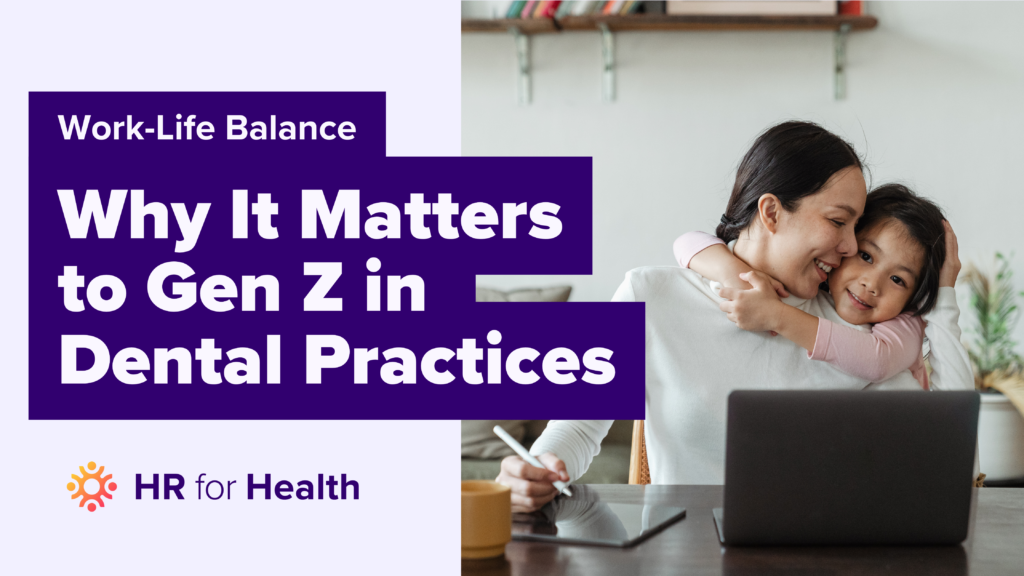At HR for Health, we understand that fostering a healthy work-life balance is essential, particularly for the newest generation entering the workforce—Generation Z. In the dental industry, where the pressure is often high, creating an environment that supports this balance is crucial. Doing so enhances job satisfaction and employee well-being and drives productivity and retention. Now, we will explore why work-life balance is vital for Gen Z in dental practices and how to effectively implement supportive strategies. What do you need to know?
What Are Gen Z’s Priorities and Values?
Generation Z values a strong work-life balance, perhaps more than any previous generation. They have grown up in a hyper-connected world where the boundaries between work and personal life are often blurred. As a result, they seek employment that offers flexibility and opportunities for mental and physical well-being. This generation is also highly socially conscious, valuing workplaces that prioritize ethical practices and sustainability.
Furthermore, Gen Z looks for roles that provide substantial personal and professional growth. They prefer environments that are not only supportive but also offer clear paths for advancement. Workplaces that fail to align with these values may struggle to attract and retain these young professionals. Understanding and addressing Gen Z’s priorities and values is crucial for dental practices aiming to foster a motivated and dedicated workforce.
The Impact of Work-Life Balance on Job Satisfaction
Work-life balance is a significant factor in job satisfaction, especially for Gen Z employees. When dental practices actively promote a balanced work environment, they often see a rise in job satisfaction, leading to higher employee retention rates. A satisfied workforce is more engaged and productive, directly impacting the quality of patient care and service.
A lack of balance, however, can lead to burnout, a common issue in high-stress environments like dental offices. This affects the health and well-being of employees and can result in higher turnover rates, increased absenteeism, and reduced productivity. Therefore, maintaining a work-life balance is beneficial and essential for sustaining a positive and productive work environment.
Strategies for Implementing Flexible Work Hours
- Staggered Shifts: Implementing staggered shifts can help accommodate Gen Z employees’ personal schedules, allowing them to start and end their workday at times that suit their personal commitments.
- Core Hours: Establish core hours during which all team members must be present and allow flexibility outside these hours. This system supports collaboration while still offering flexible work hours.
- Part-Time Options: Offer part-time employment opportunities or reduced hours for roles that do not require full-time coverage, appealing to those who value flexibility.
- Time-Off Policies: Create generous and flexible time-off policies that encourage employees to take the necessary time without feeling guilty or stressed.
- Remote Work Days: While not always feasible in dental practices, allowing administrative roles to work from home occasionally can promote a better balance.
The Role of Remote Work Opportunities in Dental Practices
Remote work is becoming increasingly popular and feasible, even in healthcare settings like dental practices. For administrative roles within a dental office, remote work can reduce commute times and enhance personal productivity, which is particularly appealing to Gen Z. This flexibility can make dental practices more attractive as employers.
Furthermore, remote work options allow dental practices to tap into a broader talent pool not limited by geographical boundaries. This can be particularly beneficial for smaller practices in remote areas. Implementing remote work responsibly can maintain or even increase productivity while promoting a better work-life balance.
Mental Health and Wellbeing: How To Support Gen Z’s Needs
- Employee Assistance Programs: Offer programs that provide confidential psychological support to employees who need it.
- Regular Check-Ins: Have managers perform regular one-on-one check-ins with employees to discuss their well-being and any support they might need.
- Mental Health Days: Encourage employees to take mental health days off when needed, without stigma or penalty.
- Workshops: Organize workshops on stress management, mindfulness, and healthy lifestyle choices to promote overall well-being.
- Physical Space for Relaxation: Designate a relaxation space in the workplace where employees can take breaks and decompress.
- Flexible Scheduling: Allow flexible scheduling to enable employees to attend mental health appointments during work hours.
- Promote Physical Activity: Encourage physical activity by organizing team sports or providing gym memberships as part of health benefits.
The Benefits of Work-Life Balance for Practice Efficiency
- Reduced Burnout: Employees with balanced lives are less likely to experience burnout, keeping productivity and practice efficiency high.
- Attraction and Retention: Practices that promote balance are more likely to attract and retain talented professionals, reducing turnover costs.
- Enhanced Reputation: A reputation for supporting work-life balance can make your practice more attractive to both potential employees and patients.
- Increased Engagement: Employees who feel their work-life balance is respected are more engaged and committed to their employer.
- Better Patient Care: Well-rested and happy employees are more likely to provide high-quality care and better patient experiences.
How to Measure and Improve Work-Life Balance in Your Practice
- Surveys: Regularly conduct anonymous surveys to gauge employee satisfaction with their work-life balance.
- Feedback Sessions: Hold feedback sessions where employees can discuss balance issues and suggest improvements.
- Monitor Work Hours: Monitor work hours to ensure employees are not regularly overworking.
- Manager Training: Train managers to recognize signs of poor balance and how to address them.
- Review Policies: Continually review and adjust work policies to better support balance.
- Technology Use: Implement technology that streamlines workflow and reduces unnecessary stress.
- Celebrate Success: Recognize and celebrate when employees achieve a good balance, encouraging others to do the same.
Contact HR for Health for Help Maximizing the Work-Life Balance of Your Talented Employees
If you want to enhance your dental practice’s work-life balance, HR for Health is here to help. Our expertise in HR solutions tailored for healthcare settings ensures that your practice can attract, support, and retain the best talent from Generation Z. Contact us today to learn how we can assist you in building a workplace culture that values and promotes a healthy balance.


